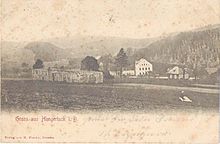Hladov (Petrovice)
Hladov (German Hungeruch ) was the northernmost village in the Aussig district ( Czech Republic ).
The old salt road led from Halle via Gottleuba to Hungertuch and through the woodland near Ober-Königswald (Libouchec) via Kleinkahn (Malé Chvojno), Saara (Žďár), Troschig (Strážky), Postitz (Božtěšice) to Aussig on the Elbe and from there across the mountains to Prague .
The district Hungertuch is at the lower end of Peterswald . This district was created on the grounds of a Meierhof, whose fields were expropriated by the land reform and sold to small farmers. The Peterswald community acquired the part of the forest belonging to Hungertuch. The fields, meadows and the forest belonged to the Schönwald dominion until the land was expropriated, including the fields around Neuhof. The rule remained only a ruin, the so-called sheepfold. Originally, however, it could not have been built as a sheepfold, as it was built in the Gothic style. Around 1913 some windows and pointed arches were still preserved. Later this ruin was demolished except for a few remains of the wall and the stones were sold as building material.
history
In 1726 Viktoria, widowed Countess Wratislaw von Mitrowitz , sold her subject Christian Kühnel the authoritarian Hungertucher Mahl- und Brettmühle along with meadows and land for 300 guilders in the Rhenish region . This mill was acquired by C. Kühnel and Gottschalk and converted into a metal goods factory. In 1933 it belonged to the Kurt Hoffmann company. With the approval of the Leitmeritz district office on September 30, 1822, the Schönwald rulers were allowed to leave some construction sites of the Meierhof Hungertuch near the village of Raiza to trusted subjects . These construction sites formed useless pasture land under the name of Bienhof . (This name appears in the oldest land register of the Peterswald community from 1577). The settlement on the Hungertucher Bienhof was given the name Neuhof with its own numbering. The Meierhof Hungertuch remained in the possession of the rulers until it was expropriated by the land reform and was leased in plots. The field names still remind of the old Meierhof: Hofefelder, stately pines in the stately, by the sheep barn.
Hungertuch has been incorporated into Peterswald since 1850 . After 1945 the village was no longer populated and abandoned.
Industry
In the second half of the 19th century, Ernst Luis Gottschall made metal clamps and parts of umbrellas in hunger cloth. The metal goods factory C. Kühnel, founded in Peterswald in 1782, was enlarged in 1871 and from 1877 to 1882 H. Kühnel expanded in Hungertuch. The C. Hoffmann company emerged in 1880 from the C. Kühnel & Co. company. The partner Ernst Louis Gottschald in Dresden took over the business in Hungertuch as an independent company. Since 1890 it was continued by Richard Dittmayer and Gustav Hoffmann from Dresden under the company name EL Gottschalds Nachsteiger and in 1907 it was taken over by C. Hoffmann alone. The company burned down twice, but was always rebuilt. Umbrella and stick components were manufactured from the beginning, later glove buttons, but Gottschald abandoned them.
swell
- Alfred Bohmann : The expulsion of the Sudeten Germans
- Franz Umlauft: History about Peterswald in the Ore Mountains
Coordinates: 50 ° 49 ′ 2 ″ N , 13 ° 59 ′ 32 ″ E


